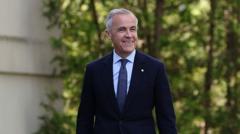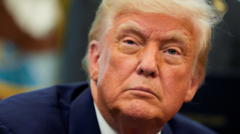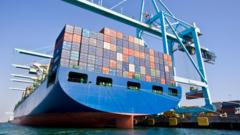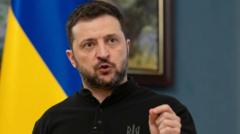President Trump’s unexpected halt on tariffs has highlighted shifting dynamics within his administration, primarily showcased by Treasury Secretary Scott Bessent’s rising influence over more hawkish officials. While some advisers push for stringent tariffs, Bessent's more moderate approach seems to be shaping policy in a way that reassures both the markets and business leaders.
Power Shifts in Trump's Tariff Strategy: The Good Cops and Bad Cops Dynamic
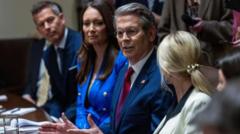
Power Shifts in Trump's Tariff Strategy: The Good Cops and Bad Cops Dynamic
As President Trump's tariff team changes, the influence of Treasury Secretary Scott Bessent emerges amid contrasting views within the White House.
In the aftermath of President Donald Trump’s surprising decision to pause several reciprocal tariffs on April 9, Treasury Secretary Scott Bessent quickly became the central figure in articulating the administration's fiscal recalibration. Addressing an eager group of reporters, the 62-year-old former hedge fund manager touted the courage needed to reach this pivotal moment. Meanwhile, key players in the tariff strategy, such as Commerce Secretary Howard Lutnick and trade adviser Peter Navarro, were conspicuously absent from the press briefing that followed, leaving Bessent to navigate the media storm alone.
Experts suggest that this media vacuum underscores a sizable shift in the power dynamic within the White House regarding tariff policies, signaling a downturn from the brink of a global trade confrontation while still maintaining Trump's overarching economic aims. "Bessent is clearly playing the good cop," remarked William Alan Reinsch, formerly of the National Foreign Trade Council. "And Lutnick and Navarro are filling the role of the bad cop."
Although the White House has remained tight-lipped concerning the events leading up to this announcement, speculation surrounds Bessent's intense communications with key business leaders, which were pivotal in influencing Trump’s decisions. Sources indicate that Bessent had engaged the President through private discussions, both aboard Air Force One and in the Oval Office, leading up to the strategic pause in tariff increases on most nations, while selectively raising levies on China.
Interestingly, it appears Bessent's previous reservations regarding tariffs and his extensive experience in the financial markets have equipped him to gain Trump's attention, steering the President away from his more hawkish advisers. “Bessent managed to alert Trump to the importance of the bond market’s signals,” noted Reinsch, who further advocated for the approach of presenting more favorable paths to the President rather than outright contradictions.
Trump’s April 9 Oval Office meeting included Bessent along with Lutnick and National Economic Council director Kevin Hassett, but two significant officials were noticeably missing from this high-stakes discussion. U.S. Trade Representative Jamieson Greer was testifying before Congress nearby and learned about the tariffs change in real-time, leading to criticism and a sense that his authority had been undermined. Navarro, known for his hardline stance on tariffs, also did not attend, further illuminating a potential reshuffling of influence within the administration, as observers suggest his input has become less favored.
The disparate messages emanating from various figures tied to tariff implementations have resulted in public confusion, with experts describing the administration’s communication as inconsistent and chaotic. Mark Sobel, a seasoned Treasury official, stated, “The lack of cohesion is palpable; it feels like whiplash listening to differing statements from Bessent, Navarro, and the President.”
Analysts suggest these varying perspectives could have been strategic—an attempt to engage various market segments and direct the narrative while simultaneously sowing confusion. Terry Haines, founder of a policy consultancy in Washington, remarked, “Throwing multiple spokespeople into the mix can cloud the situation, but it also allows voices to cater to their respective audiences.”
Haines hints that Bessent's growing prominence in tariff discussions is likely to solidify his role as the main spokesperson for economic policy moving forward, with Lutnick focusing on negotiations while other advisers assume more supporting roles. Overall, experts express optimism that a more structured approach could alleviate market fluctuations and restore investor confidence as they search for clarity in an unpredictable economic environment.
As uncertainties linger and markets respond, the evolving dynamics among Trump's tariff team could define future U.S. trade strategies, providing a glimpse into the administration's broader intentions in a world poised for economic change.

